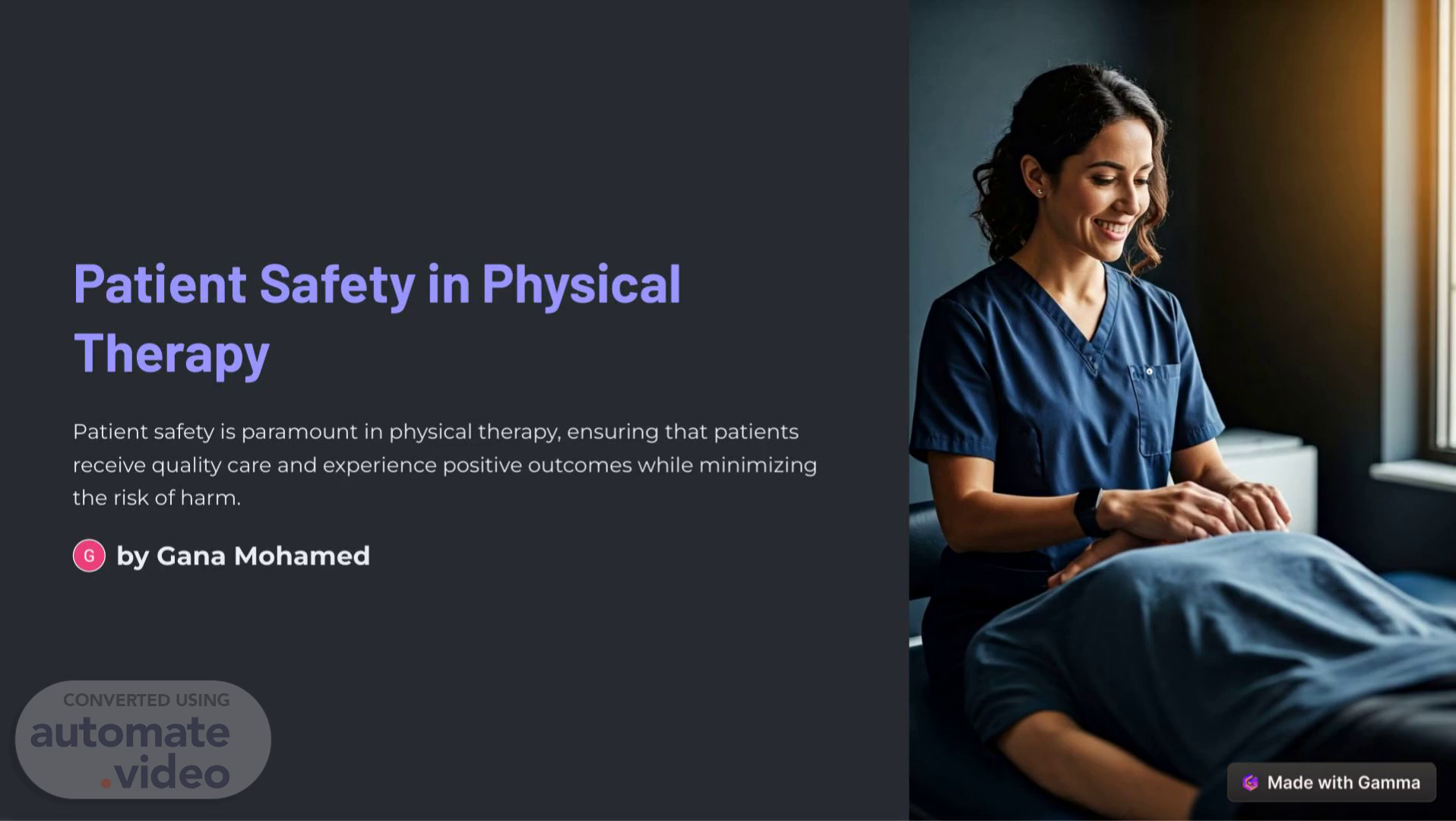Scene 1 (0s)
[Audio] Patient Safety in Physical Therapy Patient safety is paramount in physical therapy, ensuring that patients receive quality care and experience positive outcomes while minimizing the risk of harm. by Gana Mohamed.
Scene 2 (16s)
[Audio] Common Patient Safety Risks Falls Equipment Malfunction Medication Interactions Overexertion Patients may fall due to Faulty equipment can lead Incorrect medication Patients may overexert weakness, balance issues, to injuries during therapy dosages or interactions can themselves during therapy or slippery surfaces. sessions. affect a patient's ability to exercises, resulting in pain participate in therapy. or injuries..
Scene 3 (46s)
[Audio] Proper Equipment Maintenance 1 Regular Inspections 2 Calibration and Testing Thorough inspections should Equipment should be be conducted to identify any regularly calibrated and signs of wear or damage. tested to ensure accurate readings and proper functioning. 3 Maintenance Records Maintain detailed records of all inspections, repairs, and replacements to track equipment history..
Scene 4 (1m 13s)
[Audio] Role of Physical Therapists Assessment 1 Thorough evaluation of each patient's needs, risks, and limitations. 2 Treatment Planning Develop individualized plans that prioritize patient safety and address specific goals. 3 Communication Clear communication with patients, caregivers, and other healthcare professionals. 4 Supervision Close supervision of patients during therapy sessions to ensure safety and intervene if needed. 5 Education Educating patients on safe exercise techniques and selfcare practices..
Scene 5 (1m 48s)
[Audio] Safe Exercise Techniques Warm-Up Start with gentle movements to prepare the body for 1 exercise. Progressive Overload Gradually increase intensity and duration of exercises as 2 tolerated. Proper Form Emphasize correct form and alignment to reduce strain and 3 injury risk. Rest and Recovery Allow adequate time for muscle recovery between sessions 4 and exercises..
Scene 6 (2m 15s)
[Audio] Patient Education on Safety Exercise Guidelines Fall Prevention Provide clear instructions on Educate patients on strategies proper exercise techniques and to reduce fall risk, such as using precautions. assistive devices and maintaining a clutter-free environment. Medication Management Reporting Concerns Explain the potential effects of Encourage patients to report medication on therapy and the any pain, discomfort, or importance of taking unusual symptoms promptly. medication as prescribed..
Scene 7 (2m 49s)
[Audio] Ergonomics in Physical Therapy Proper Chair Workstation Setup Manual Handling Use chairs with adjustable height and Ensure the height of the table is Use proper lifting techniques and lumbar support to maintain a neutral adjusted to avoid strain on the neck and assistive devices to minimize strain on spine. shoulders. the back and muscles..
Scene 8 (3m 12s)
[Audio] Infection Control and Hygiene 1 Hand Hygiene Thorough hand washing before and after each patient encounter. 2 Equipment Sanitization Regular cleaning and disinfection of all equipment used for patients. 3 Personal Protective Equipment (PPE) Wearing gloves, masks, and gowns when appropriate to prevent the spread of infections..
Scene 9 (3m 38s)
[Audio] Handling and Transferring Patients 1 2 Assessment Communication Evaluate the patient's strength, Explain the transfer procedure to mobility, and any pain limitations. the patient and obtain their consent. 3 4 Assistance Safety Precautions Utilize appropriate assistive devices Ensure a safe and clear transfer and seek assistance from path with no obstacles or tripping colleagues if needed. hazards..
Scene 10 (4m 7s)
[Audio] Creating a Safe Environment. Creating a Safe Environment.
